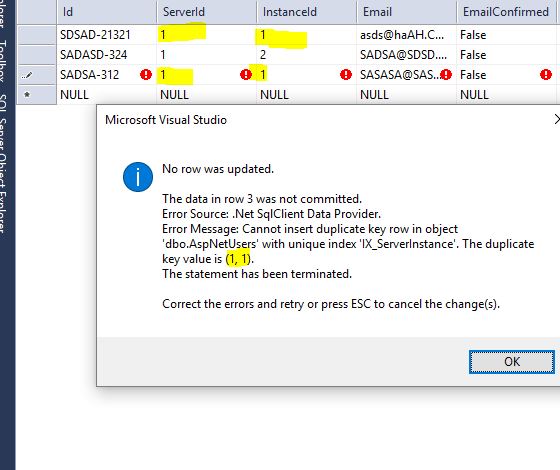There are few ways to configure an Index on more than one property in the entity framework 6.1. I created a new WebApplication project from Visual Studio and I selected MVC.
1.Attributes
For this tutorial I am going to create two models: Server and Instance.
public class Server
{
public int Id { get; set; }
public string Name { get; set; }
}
public class Instance
{
public int Id { get; set; }
public string Name { get; set; }
}
- Modify the ApplicationUser class:
public class ApplicationUser : IdentityUser
{
public async Task<ClaimsIdentity> GenerateUserIdentityAsync(UserManager<ApplicationUser> manager)
{
// Note the authenticationType must match the one defined in CookieAuthenticationOptions.AuthenticationType
var userIdentity = await manager.CreateIdentityAsync(this, DefaultAuthenticationTypes.ApplicationCookie);
// Add custom user claims here
return userIdentity;
}
public Server Server { get; set; }
ForeignKey(nameof(Server))]
[Index("IX_ServerInstance", 1, IsUnique = true)]
public int ServerId { get; set; }
public Instance Instance { get; set; }
[ForeignKey(nameof(Instance))]
[Index("IX_ServerInstance", 2, IsUnique = true)]
public int InstanceId { get; set; }
}
IMPORTANT NOTE
If the property “instaceId” was a string , the [MaxLength(somenumber)] attribute would be needed to be applied.
For example:
[MaxLength(50)]
[Index("IX_ServerInstance", 2, IsUnique = true)]
public string InstanceName { get; set; }
2.Fluent Api
- In the ApplicationDbContext override the method OnModelCreating and add the following code:
protected override void OnModelCreating(DbModelBuilder modelBuilder)
{
modelBuilder
.Entity<ApplicationUser>()
.Property(t => t.ServerId)
.HasColumnAnnotation(
IndexAnnotation.AnnotationName,
new IndexAnnotation(
new IndexAttribute("IX_FirstNameLastName", 1) { IsUnique = true }));
modelBuilder
.Entity<ApplicationUser>()
.Property(t => t.InstanceId)
.HasColumnAnnotation(
IndexAnnotation.AnnotationName,
new IndexAnnotation(
ew IndexAttribute("IX_ServerInstance", 2) { IsUnique = true }));
}
3.Migrations
If a migration is created( Add-Migration) and 1st way(with the attribute) was used, the following code is generated automatically:
CreateTable(
"dbo.AspNetUsers",
c => new
{
Id = c.String(nullable: false, maxLength: 128),
ServerId = c.Int(nullable: false),
InstanceId = c.Int(nullable: false),
Email = c.String(maxLength: 256),
EmailConfirmed = c.Boolean(nullable: false),
PasswordHash = c.String(),
SecurityStamp = c.String(),
PhoneNumber = c.String(),
PhoneNumberConfirmed = c.Boolean(nullable: false),
TwoFactorEnabled = c.Boolean(nullable: false),
LockoutEndDateUtc = c.DateTime(),
LockoutEnabled = c.Boolean(nullable: false),
AccessFailedCount = c.Int(nullable: false),
UserName = c.String(nullable: false, maxLength: 256),
})
.PrimaryKey(t => t.Id)
.ForeignKey("dbo.Instances", t => t.InstanceId, cascadeDelete: true)
.ForeignKey("dbo.Servers", t => t.ServerId, cascadeDelete: true)
.Index(t => new { t.ServerId, t.InstanceId }, unique: true, name: "IX_ServerInstance")
.Index(t => t.UserName, unique: true, name: "UserNameIndex");
But it’s possible to create index on many properties on a later migration. For example on the up method of the new migration the following code is needed to be added:
//Another alternative
CreateIndex("dbo.AspNetUsers", new []{ "ServerId", "InstanceId" },true, "IX_ServerInstance");
Result
References MSDN


